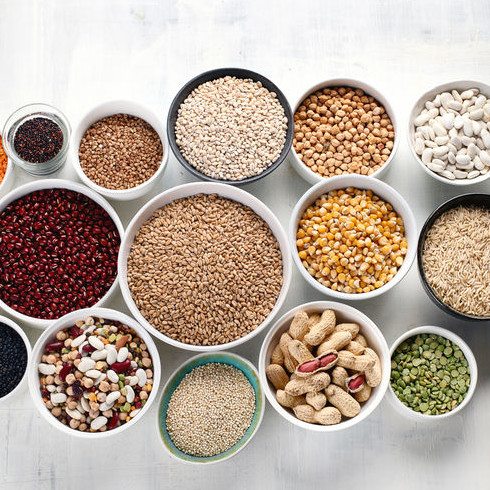
High Protein Baking
What is High Protein Baking?
Diets high in protein are popular for their potential benefits in staving off hunger and weight gain control. Because of these properties, consumers are seeking out baked goods high in protein.
The Nutrition Labeling and Education Act (NLEA) of 1990 allows for the nutrient content claim “high protein” on food labels.1 FDA authorizes this claim when 20% or more of the daily value (DV) of protein is found in the Reference Amount Customarily Consumed (RACC).2 Based on a 2000 calorie diet, the DV of protein is 50 grams per day.3
Therefore, greater than 10 grams of protein in RACC is needed for a high protein claim.
Origin
Protein is found in foods from both plants and animals and is made up of amino acids. There are twenty different amino acids, nine of which are considered essential and must be obtained from food.
Cereal grains tend to have less of the essential amino acid lysine while pulses tend to have more. In contrast, pulses tend to have less methionine and tryptophan while grains are higher in these sulfur-containing amino acids.4
When cereal grains and legumes are combined in food products, they are called “complementary proteins.” Combining these plant sources provides most of the essential amino acids.
Protein is an important nutrient for growth and development as well as providing energy. Incorporating ingredients such as soy, whey, nuts, grains, eggs, beans, peas, grains and seeds into traditional bread recipes will enhance the protein content and quality of baked goods. Nutritionists recommend we get a variety of protein sources in our diets.
Sources of high protein
Options to increase protein content in baked items include:
- Beans and Pulses:
- Chickpea powder (25-28% protein)
- Faba Bean powder (20% protein)5
- Pea Protein Powder (75% protein)5
- Lupin Flour (36% protein)5
- Soy protein Isolate (88% protein)5
- Soy Flour (38-50% protein)4
- Eggs
- Egg Whites (10% protein)5
- Egg Yolk (15% protein)5
- Grains/Pseudo-grains
- Milk
- Whey protein (11-90% protein)
- Caseinates (92% protein)
- Nuts
- Almond Butter (24% protein)
- Macadamia (7% protein)
- Pecans (9% protein)
- Walnuts (15% protein)
- Nutritional yeasts ( 50% protein)
- Seeds
- Amaranth Flour (16% protein)
- Quinoa Flour (14% protein)
Nutrition
For a high protein nutrient claim, quality is as important as quantity. Protein quality is characterized by the amount and type of essential amino acids they provide. A method to evaluate the protein content of food is called the protein digestibility-corrected amino acid score (PDCAAS). For example, casein has a PDCAAS of 1.0 and is considered fully digestible in humans.7
Application
The source and amount of protein can affect the texture of baked goods as well as the overall structure in breads. They can also affect the dough’s machinability.
Adding a protein source to a baked good must be done with care and consideration. Hydration and elasticity of the dough as well as gluten matrix could be affected.
Read more about gluten hydration, water absorption, dough mixing and texture profile analysis.
FDA regulation
FDA requires that the corrected protein value using the PDCAAS is used in the calculation for any nutrient content claim on a label. FDA does not provide PDCAAS, so if you want to make a protein claim, you will need to research or test for PDCAAS per the requirements in 21 CFR 101.9(c) (7) (ii).
Protein Digestibility Corrected Amino Acid Scores (WHO/FAO4)
| Product | PDCAAS |
| Casein | 1.0 |
| Egg White | 1.0 |
| Pea Flour | 0.92 |
| Faba Bean | 0.47 |
| Chickpea | 0.71 |
| Soybean Protein | 0.99 |
| Wheat Gluten | 0.25 |
| Peanut Meal | 0.52 |
| Whole Wheat | 0.40 |
References
- Center for Food Safety and Applied Nutrition. Labeling & Nutrition-Label Claims for Conventional Foods and Dietary Supplements. https://www.fda.gov/food/labelingnutrition/ucm111447.htm, Accessed on 30 November 2018.
- The Food and Drug Administration. A Food Labeling Guide. https://www.fda.gov/downloads/Food/GuidanceRegulation/GuidanceDocumentsRegulatoryInformation/UCM265446.pdf, Accessed on 30 November 2018.
- The Food and Drug Administration. Protein. https://www.accessdata.fda.gov/scripts/InteractiveNutritionFactsLabel/factsheets/Protein.pdf, Accessed on 30 November 2018.
- Pulse Canada. Protein Quality of Cooked Pulses. http://www.pulsecanada.com/wp-content/uploads/2017/09/Pulses-and-Protein-Quality.pdf. Accessed 4 December 2018.
- United States Department of Agriculture. USDA Food Composition Databases.https://ndb.nal.usda.gov/ndb/search/list, Accessed on 4 December 2018.
- Venerande, B. Mohamed, S. Fatiou, T. Houndouigan, J. “Structure and Nutritional Composition of Fonio (Digitaria Exilis) Grains: A Review”, Int. Res. J. Biological Sci. 2(1), 2013, pp. 73-79.
- Food and Agriculture Organization of the United Nations. Protein Quality Evaluation, Food and Nutrition Paper 51, Accessed on 30 November 2018.

